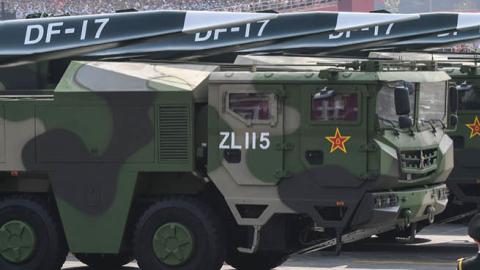The Financial Times report about China's new hypersonic weapon has caused a stir among the Washington policy class. The FT indicated that China's experimental weapon circumnavigated the globe before reentering the atmosphere and landing within 20 miles of its intended target. The Chinese Foreign Ministry, rather than the PLA, issued a response – spokesman Zhao Lijian did not deny the test but claimed that China had launched an experimental spacecraft rather than a hypersonic vehicle. Of course, what goes up must come down: throughout the Cold War, West and East used their space programs to develop their nuclear capabilities.
Nevertheless, the report and China’s reaction to it are curious. The fact that the Foreign Ministry handled questions rather than the PLA indicates the sensitivity of the issue. For another, the FT’s five anonymous sources were simply “familiar” with the test – the publication did not indicate whether they were PLA officers, Chinese intelligence officials, American military or intelligence officers, or had some other background.
The test itself is also odd, given China’s historical nuclear doctrine. China has been a nuclear power since 1964 and has a missile arsenal similar to that of the United States and Russia. It relies upon a traditional "triad", distributing weapons between land-based launchers, strategic bombers, and submarines. But unlike the U.S. and Russia, and Russia's Soviet predecessor, China has never fielded a major nuclear arsenal. It neither subscribed to the Soviet view that some degree of nuclear superiority was necessary for victory in a conventional conflict, nor the American view that massive retaliation – technically abandoned after the Eisenhower administration, but logically embodied in Mutually Assured Destruction – required an arsenal large enough to withstand a Soviet first-strike.
Historical contingency explains this disparity. Mao Zedong discounted the relevance of nuclear weapons, given the contradiction between high-technology bombs and his commitment to "People's War," with its reliance upon manpower and will vice technological factors. Mao's death in 1976 enabled a doctrinal reassessment. But Deng Xiaoping completed China's geopolitical reorientation, beginning with Henry Kissinger's secret visit to China in 1971, effectively making it an American co-belligerent in a prospective NATO-Soviet confrontation. China's contribution to this de facto alliance would not be nuclear. Rather, a less hostile China would no longer threaten Taiwan or the western Pacific’s sea lanes, freeing U.S. and allied resources for use against the Soviets. Moreover, the PLA would threaten the extended Sino-Soviet land border, forcing Moscow to divert resources and attention from the European central front. Indeed, the ostensibly outlandish objectives of "The Maritime Strategy," the U.S. Navy's strategic concept in the 1980s, become much more reasonable when one accounts for Chinese support: landing U.S. forces in eastern Russia and fighting across Siberia would have been another component of a multi-front counteroffensive against the Soviets.
As it stands, the PLA has a nuclear stockpile of approximately 350 nuclear warheads, of which 200 to 300 are currently deployed. If these estimates are correct – and it is worth noting that, despite repeated assertions to the contrary, no evidence exists that China maintains a secret arsenal of 1,000 or more warheads – China's deployed arsenal is slightly larger than France's, or twice the size of the United Kingdom's. This is compared to Russia's deployed force of 1,600 warheads and the U.S.’ of 1,650.
This is not to deny the relevance of nuclear weapons in Chinese strategy. The CCP requires a large and distributed nuclear arsenal to survive a decapitation strike and inflict damage upon an adversary. Yet, the comparison is illustrative. The most critical leg of the nuclear triad is naval. Airbases and missile silos are fixed targets, subject to precision strikes. Nuclear-powered ballistic missile submarines, by contrast, are stealthy, can remain on deterrence patrols for months, and can strike from unexpected areas given their access to the ocean’s vastness. The PLA Navy operates six Jin-class SSBNs, each of which can carry 12 JL-2 SLBMs. Two more Jin-class boats are planned, along with six Type-096 SSBNs, each carrying 16 JL-3 SLBMs. Compare this, however, to the U.S.' aging force of 14 Ohio-class SSBNs, each of which is equipped with 24 Trident-II SLBMs and its replacement with 12 new Columbia-class SSBNs.
China’s nuclear arsenal is not meant to destroy the U.S. outright. Rather, the CCP’s calculation seems to be that, beyond a certain point, it will become prohibitively expensive for the U.S. to construct missile defenses and fallout shelters sufficient to mitigate casualties down from one-fifth of its population. In nuclear terms, all the PLA must do is prove itself capable enough of inflicting significant damage upon U.S. population centers to establish deterrence: unlike the Soviets, and perhaps contemporary Russia or China, the U.S. would not sacrifice even a twentieth of its population for an unquestioned strategic victory over a competitor. And despite the Reagan administration’s Strategic Defense Initiative, the U.S. has never seriously considered investing in anti-ballistic missile systems at the scale needed to counter great-power arsenals.
Nevertheless, China’s hypersonic ballistic missile test has a clear strategic point. Medium range or intercontinental ballistic missiles mounted with hypersonic warheads would provide China with a theater-based first strike advantage. The core difficulty facing Chinese strategists is the disparity between the PLA’s power-projection capabilities beyond the First Island Chain and their core interests far beyond it – specifically the ability to pressure Japan by controlling the Philippine Sea and, more critically, the ability to secure resource flows into China through the Indian Ocean, whether they transit Malacca or Gwadar.
China has attempted to address this range issue by constructing traditional supercarriers, increasing its submarine fleet, and procuring more range-extenders for its ground-based fighters and bombers. But China's carriers, the most important aspect of this strategy, will not reach the fleet until later this decade. And as COVID-19 and the Evergrande collapse demonstrate, the CCP may not be able.
Ballistic missile-mounted hypersonic weapons help remedy this range issue immediately. Hypersonics travel far faster than standard missiles – at minimum six times faster. When attached to a ballistic missile, they can strike virtually any target in the world. U.S. theater missile defenses will find it difficult to counter them, as will U.S. point defenses, like those incorporated into a standard Carrier Strike Group. Moreover, a nuclear warhead would mitigate accuracy issues. During the Cold War, the Soviets considered this sort of strike using nuclear-tipped P-50 0 Bazalt cruise missiles deployed from Slava-class cruisers to destroy U.S. carriers pressuring the Soviets in the Norwegian and Barents Seas.
U.S. media coverage of China’s advertised hypersonic missile capability helps explain the large issue of the arms race that exists between the U.S. and China. But Chinese nuclear doctrine is inconsistent with developing hypersonics as a strategic threat to the U.S. in addition to the weapons systems that the PLA already possesses. The “hype” in “hypersonics” is a more accurate picture of what China is trying to achieve in its unclear public mention of recent missile tests.
Read in RealClear Defense

















